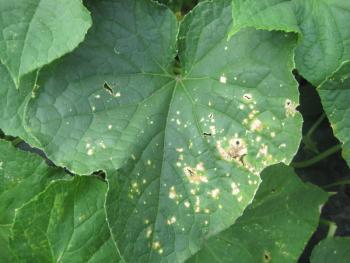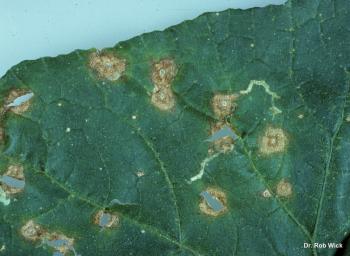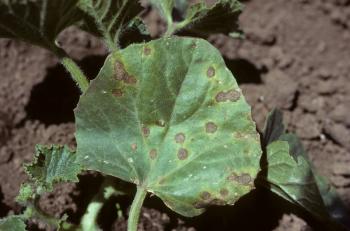Cucurbits, Leaf Spots
There are several diseases that cause leaf spots on these crops and they can often be hard to tell apart. Below are descriptions of some the more common fungal and bacterial leaf spots found on cucurbit crops in MA that we hope will help you tease them apart in the field. Of course a diagnosis from a trained pathologist in the lab is ideal, but we understand it is not always possible to test every spot you encounter.
Angular leaf spot (Psuedomonas syringae pv. lachrymans)
Angular leaf spot can affect all cucurbits, but cucumbers are most commonly affected. It is caused by the bacterium Pseudomonas syringae pv. lachrymans. This disease is usually among the first to show up because it is seed-borne. It will start to appear in the early to mid-season. Small, round water-soaked spots appear on leaf tissue, and expand until they are confined by veins, giving them the characteristic angular look. Under moist conditions a milky white exudate containing bacterial cells may ooze out of the lesion on the lower leaf surface. These wetlooking spots will dry out and turn yellow-brown or the dead tissue may fall out leaving a “shot-hole” appearance. Yellowing of the leaf between lesions may occur where disease severity is high. Similarly, water-soaked spots may appear on stems and petioles, drying out to form a whitish crust. Spots can also appear on fruit, where they are tiny and water-soaked but dry to form whitish, chalky, spots. These spots cause internal decay of fruit, and fruit that is infected early may be deformed. Affected plants will grow poorly, produce less fruit, and affected fruit is unmarketable.
As with other bacterial diseases, outbreaks of angular leaf spot are often initiated from infected seed. Bacteria proliferate in warm, moist weather and are spread from plant to plant by water, commonly in the form of splashing rain or runoff, as well as by insects or workers moving through the field.
Cultural controls:
- Use resistant varieties.
- Use drip irrigation to reduce spread of bacteria by overhead irrigation.
- Don’t work in wet fields or work in clean sections of the field first and infected sections last to avoid spreading the disease to unaffected areas or to new plantings.
- If you catch the disease early, before it is widespread and severe, copper may be effective in reducing its spread.
- Till in residues quickly after harvest to get that infected tissue breaking down quickly. Bacteria survive on residues as long as it is present, up to two years.

Image 1. Angular leaf spot on zucchini, S. Scheufele
Anthracnose (Colletotrichum orbiculare)
For more information on this disease, please see our main Cucurbits, Anthracnose article.
Anthracnose affects mostly melons, watermelons and cucumbers; squash and pumpkins are less susceptible. The disease is caused by the fungus Colletotrichum orbiculare which, like other anthracnose fungi, causes characteristic black, sunken lesions on affected fruit. Leaf spots are light brown or reddish and appear near veins so may cause leaf distortion. These lesions dry out and the dead issue may fall out, again leaving a “shot-hole” appearance. On stems and petioles, lesions are elongated and tan. The fruit lesions are large, circular, sunken areas that turn black and may produce a pink ooze under humid or moist conditions.
The fungus can be seed-borne and also survives on crop residue or volunteer plants (maybe in your compost or cull pile?). Humid, rainy weather is necessary for disease to occur. There are three races of the fungus that affect different crops. Resistant cucumber and watermelon varieties are available, but there are no resistant melon varieties. There are many fungicides labeled for control of anthracnose; please see the New England Vegetable Management Guide for recommendations.
Image 2. Anthracnose lesions on watermelon fruit, OMAFRA

Image 3. Anthracnose leaf spot, R.L. Wick
Alternaria Leaf Spot (Alternaria cucumerina)
For more information on this disease, please see our main Cucurbits, Alternaria Leaf Spot article.
Alternaria leaf spot affects all cucurbit crops but is most common on cantaloupe. The disease is caused by the fungus Alternaria cucumerina which, like other Alternaria species, can cause a characteristic target-like spot. Usually, leaf spots start out as small tan flecks that enlarge and merge together. These larger spots (up to a half inch) may exhibit the concentric rings common of Alternaria fungi. This disease usually occurs in mid-season and can reduce late-season fruit production. Fruit lesions may also occur–they appear as zonate, sunken lesions with dark, olive-green, felt-like sporulation present. Spores are spread from plant to plant via splashing rain or overhead irrigation, as well as by insects, workers, and equipment moving through the field. The fungus survives on crop residue in the soil as long as it is present. A two year rotation away from cucurbit hosts is usually sufficient.

Image 4. Alternaria leaf spot on cantaloupe, G. Holmes
Septoria Leaf Spot (Septoria cucurbitacearum)
Septoria leaf spot is less common, occurring in cool summers or late fall. The disease is caused by the fungus Septoria cucurbitacearum which creates small, almost white round spots on leaves and superficial raised tan bumps on fruit. The fungus survives on crop residue in the soil which persists one to two years. Spores are spread from plant to plant via splashing rain or overhead irrigation, as well as by insects, workers, and equipment moving through the field.

Image 5. Septoria leaf spot on cucumber, R.L. Wick
Scab (Cladosporium cucumerinum)
For more information on this disease, please see our main Cucurbits, Scab article.
Scab, caused by the fungus Cladosporium cucumerinum, can be a significant problem for summer and winter squash, pumpkin, melon, and watermelon. Lesions may occur on leaves, stems, petioles, and fruit, with fruit spots being the most damaging. Leaf spots are small, pale-yellow to white, and again the dead tissue in the center of the lesion may fall out leaving a “shot-hole” appearance. Leaf lesions may not occur. Lesions on stems are elongate and light colored, and if numerous may cause the internodes to shorten, giving the plant a deformed virus-like appearance. Scab lesions on fruit are sunken, irregular cavities with corky margins, and may produce a golden brown ooze which dries into brown beads. Sporulation on lesions may occur, giving them an olive-green, felt-like appearance.
This disease usually occurs in mid-summer and is favored by cool dry days and rainy or dewy nights. The pathogen survives in crop residues which persist one to two years in soil. Tolerant varieties of cucumber are available. Chlorothalonil, mancozeb, or polyoxin D can be used preventively, at the first sign of disease.
The Center for Agriculture, Food and the Environment and UMass Extension are equal opportunity providers and employers, United States Department of Agriculture cooperating. Contact your local Extension office for information on disability accommodations. Contact the State Center Director’s Office if you have concerns related to discrimination, 413-545-4800 or see ag.umass.edu/civil-rights-information.

